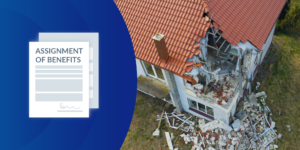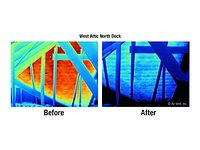What is an Assignment of Benefits (AOB)?
Written by wpengine
- Pinterest 0
In storm prone locations, such as Florida, homeowners needing repairs have historically come across the term AOB (assignment of benefits). According to the Florida Office of Insurance Regulation , assignment of benefits (AOB) is defined as:
“a document signed by a policyholder that allows a third party, such as a water extraction company, a roofer, or a plumber, to ‘stand in the shoes’ of the insured and seek direct payment from the insurance company. ”

An AOB scenario
So, what does that mean exactly? Picture it. A hurricane hits your area. You have roof damage. You call a roofer for an estimate. They say they will do the work for you, but you just need to sign an AOB agreement. By signing the AOB, the repair company now has the right to correspond directly with the insurance company. It completely bypasses you, the homeowner. However, the only priority is getting your roof fixed. So, rather than questioning it, or taking the time to get multiple quotes, you reluctantly agree.
After agreements are signed, the contractor completes your repair. The contractor may or may not complete the repair up to the standard you are expecting. “Some contractors might abuse that AOB by doing a poor job or an overly expensive job and then billing the insurance company an excessive amount,” explains James Lynch , chief actuary and vice president of research and education at the Insurance Information Institute.
What does this mean for me as the homeowner?
While the risks of signing an AOB can range, the most common is a repair job that isn’t up to snuff. In other words, a job that will not last as long as it should. Additionally, the AOB can contain language that gives the repair company (the 3rd party), the ability to negotiate and endorse claim payments in your name, or even file suit against the insurance company- most likely without your knowledge.
Additionally, according to the Florida Office of Insurance Regulation, “you may be responsible for the payment of additional costs if the insurance company does not pay the third party the full amount requested and a lien may be placed on your home if you fail to pay.”
Do I have to sign an AOB?

In fact, while signing an AOB has never been required of a homeowner, new AOB legislation was recently signed by Florida Governor Ron DeSantis . The legislation, which takes effect July 1st, is a true overall. “By signing House Bill 7065, we will better protect consumers from those who would take advantage of them by abusing the Assignment of Benefits process,” Florida Insurance Commissioner David Altmaier said in a statement after DeSantis signed the bill.
In the End…
Having storm damage on your house is never an ideal experience. More so, giving someone else the ability to deal with your insurance company may seem like a way to make the experience a little less cumbersome for you, the homeowner. However, having a reputable contractor that will help you navigate that process, while allowing you to maintain all your rights as a insurance policy holder, is the most advisable course of action.
Are there any questions about AOB’s that we can help answer? We are here to help!

- For Consumers
- Industry Professionals
- News & Publications
- Convention & Expo
- Member Login
- Consumer Info
How Assignment of Benefits Work
Cam Fentriss, FRSA LEGISLATIVE COUNSEL
If you are a roofing contractor, you are most likely getting a lot of e-mails from lawyers, hail mapping companies, and other businesses that specialize in finding customers who can suddenly be in need of a new roof at the expense of their insurance company. Hmm – does that sound a little odd to you? It should and it is.
This scheme is something that was used with sinkholes and mold until the insurance industry found a way to shut the abusive practices down by excluding or limiting the claims. The same thing is now happening with so-called “water restoration” companies and the attorneys and sales companies that promote this are moving aggressively into the roofing industry.
For the water restoration work, the statistics are incredible. In 2014, for Citizens’ Property Insurance Company, non-weather related water damage accounted for 56 percent of claims. That is absolutely ridiculous.
Here is a rough idea of how it works. A property owner has a leak and calls a plumber. The plumber fixes the leak, then refers customer to a water damage company (that will be paying the plumber a referral fee, sometimes $1,000 or more). The water damage company’s agreement for the work includes an “assignment of benefits” (or AOB) that says the customer assigns his insurance benefits to the water damage company.
Once the contract with an AOB is signed, then the water damage company as good as has a license to do 10 or 20 times more work than what is needed. With the AOB, the insurance company has to answer to the water damage company, not the policyholder. If the insurance company does not pay up, then the water damage company sends it to the lawyer who taught the water damage company how to do these contracts with an AOB. That lawyer files a lawsuit and the bills start to go up, up, up.
These lawyers are very smart. They know very well that this type of work cannot last very long before the insurance industry and the government find a way to stop it. They know that the millions from water damage claims is about to dry up, so they are working very hard to migrate over to roofing work so they can drain every dime out of our industry before insurers put a stop to that too.
The question for us is whether we want to stand by and watch a few roofing contractors make a lot of money for a short time before property insurers rewrite their policies to dramatically cut the funds that will be paid for a damaged roof. Until the insurers and regulators catch up, these aggressive sales forces will continue to march across our state finding “reasons” people need a new roof and greedy lawyers will be more than happy to file one lawsuit after another to pressure insurance companies to pay up.
Some may be tempted to believe that insurers and regulators would never allow the same kinds of limits or exclusions for roofing work coverage as exist for less crucial work like mold. But it’s not really a matter of choice if you want to keep property insurers in Florida and you want to provide insurance that people can actually afford. As the number of claims goes up, at some point, they will have to increase the rates to cover the additional cost. They will have the statistics to show exactly why a rate increase is needed and, before the government allows enormous increases in premiums, limitations on payments for roofing work will be on the table.
Anna Cam Fentriss is an attorney licensed in Florida since 1988 representing clients with legislative and state agency interests. Cam has represented FRSA since 1993, is an Honorary Member of FRSA, recipient of the FRSA President’s Award and the Campanella Award in 2010. She is a member of the Florida Building Commission Special Occupancy Technical Advisory Committee, President of Building A Safer Florida Inc. and past Construction Coalition Chair (1995-1997).
Bookmark & Share
Previous Article
- OSHA Confined Space Standard for Construction Part I
Next Article
- Roof Tile Underlayment
Popular tags on this blog
Most popular articles.
- Florida Law Requires State Licensed Contractors Perform Roofing Work
- PEO's, Certificates of Insurance and Subcontractors
- Consumer Protection Coalition Urges Homeowners to Watch for AOB Scams
- Blue Tarp Roof Announcement
- Governor Scott announced Operation Blue Roof to help families temporarily repair their roofs at no cost.
- FRSA Urges Homeowners to Use Caution When Hiring for Reroofing or Roof Repairs
- Hurricane Preparedness and Recovery: Hire a State-Licensed Contractor
- Consumer Protection Coalition Warns Consumers to Beware of Assignments of Benefits Abuse Following Hurricane Michael
Related Articles
- How Voluntary Benefits Can Help Recruitment and Retention Efforts - December 2022
- Recruiting Millennials Will Require Changes in The Roofing Industry - March 2022
- Mental Health is Still a Top Construction Issue ? a Benefits Strategy Adjustment Can Help
- When It Rains, It Pours... Fighting the Fly-By-Night Contractors
- Received a document?
Assignment of Benefits for Contractors: Pros & Cons of Accepting an AOB

22 articles
Insurance , Restoration , Slow Payment

When a property owner files an insurance claim to cover a restoration or roofing project, the owner typically deals directly with the insurance company. They may not have the funds available to pay the contractor out of pocket, so they’re counting on that insurance check to cover the construction costs.
But insurance companies often drag their feet, and payments can take even longer than normal. Contractors often wish they could simply deal with the insurance company directly through an assignment of benefits. In some circumstances, an AOB can be an effective tool that helps contractors collect payment faster — but is it worth it?
In this article, we’ll explain what an assignment of benefits is, and how the process works. More importantly, we’ll look at the pros and cons for restoration and roofing contractors to help you decide if an AOB is worth it .
What is an assignment of benefits?
An assignment of benefits , or AOB, is an agreement to transfer insurance claim rights to a third party. It gives the assignee authority to file and negotiate a claim directly with the insurance company, without involvement from the property owner.
An AOB also allows the insurer to pay the contractor directly instead of funneling funds through the customer. AOBs take the homeowner out of the claims equation.
Here’s an example: A property owner’s roof is damaged in a hurricane. The owner contacts a restoration company to repair the damage, and signs an AOB to transfer their insurance rights to the contractor. The contractor, now the assignee, negotiates the claim directly with the insurance company. The insurer will pay the claim by issuing a check for the repairs directly to the restoration contractor.
Setting up an AOB
A property owner and contractor can set up an assignment of benefits in two steps:
- The owner and the contractor sign an AOB agreement
- The contractor sends the AOB to the insurance company
Keep in mind that many states have their own laws about what the agreement can or should include .
For example, Florida’s assignment of benefits law contains relatively strict requirements when it comes to an assignment of benefits:
- The AOB agreements need to be in writing. The agreement must contain a bolded disclosure notifying the customer that they are relinquishing certain rights under the homeowners policy. You can’t charge administrative fees or penalties if a homeowner decides to cancel the AOB.
- The AOB must include an itemized, per-unit breakdown of the work you plan to do. The services can only involve how you plan to make repairs or restore the home’s damage or protect the property from any further harm. A copy must be provided to the insurance company.
- A homeowner can rescind an AOB agreement within 14 days of signing, or within 30 days if no work has begun and no start date was listed for the work. If a start date is listed, the 30-day rule still applies if substantial progress has not been made on the job.
Before signing an AOB agreement, make sure you understand the property owner’s insurance policy, and whether the project is likely to be covered.
Learn more – Assignment of Benefits: Ultimate Guide for Contractors & Policyholders
Pros & cons for contractors
It’s smart to do a cost-benefit analysis on the practice of accepting AOBs. Listing pros and cons can help you make a logical assessment before deciding either way.
Pro: Hiring a public adjuster
An insurance carrier’s claims adjuster will inspect property damage and arrive at a dollar figure calculated to cover the cost of repairs. Often, you might feel this adjuster may have overlooked some details that should factor into the estimate.
If you encounter pushback from the insurer under these circumstances, a licensed, public adjuster may be warranted. These appraisers work for the homeowner, whose best interests you now represent as a result of the AOB. A public adjuster could help win the battle to complete the repairs properly.
Pro: More control over payment
You may sink a considerable amount of time into preparing an estimate for a customer. You may even get green-lighted to order materials and get started. Once the ball starts rolling, you wouldn’t want a customer to back out on the deal.
Klark Brown , Co-founder of The Alliance of Independent Restorers, concedes this might be one of the very situations in which an AOB construction agreement might help a contractor. “An AOB helps make sure the homeowner doesn’t take the insurance money and run,” says Brown.
Pro: Build a better relationship with the homeowner
A homeowner suffers a substantial loss and it’s easy to understand why push and pull with an insurance company might be the last thing they want to undertake. They may desire to have another party act on their behalf.
As an AOB recipient, the claims ball is now in your court. By taking some of the weight off a customer’s shoulders during a difficult period, it could help build good faith and further the relationship you strive to build with that client.
Learn more : 8 Ways for Contractors to Build Trust With a Homeowner
Con: It confuses payment responsibilities
Even if you accept an AOB, the property owner still generally bears responsibility for making payment. If the insurance company is dragging their feet, a restoration contractor can still likely file a mechanics lien on the property .
A homeowner may think that by signing away their right to an insurance claim, they are also signing away their responsibility to pay for the restoration work. This typically isn’t true, and this expectation could set you up for a more contentious dispute down the line if there is a problem with the insurance claim.
Con: Tighter margins
Insurance companies will want repairs made at the lowest cost possible. Just like you, carriers run a business and need to cut costs while boosting revenue.
While some restoration contractors work directly with insurers and could get a steady stream of work from them, Brown emphasizes that you may be sacrificing your own margins. “Expect to accept work for less money than you’d charge independently,” he adds.
The takeaway here suggests that any contractor accepting an AOB could subject themselves to the same bare-boned profit margins.
Con: More administrative work
Among others, creating additional administrative busywork is another reason Brown recommends that you steer clear of accepting AOBs. You’re committing additional resources while agreeing to work for less money.
“Administrative costs are a burden,” Brown states. Insurers may reduce and/or delay payments to help their own bottom lines. “Insurers will play the float with reserves and claims funds,” he added. So, AOBs can be detrimental to your business if you’re spending more while chasing payments.
Con: Increase in average collection period
Every contractor should use some financial metrics to help gauge the health of the business . The average collection period for receivables measures the average time it takes you to get paid on your open accounts.
Insurance companies aren’t known for paying claims quickly. If you do restoration work without accepting an AOB, you can often take action with the homeowner to get paid faster. When you’re depending on an insurance company to make your payment, rather than the owner, collection times will likely increase.
The literal and figurative bottom line is: If accepting assignment of benefits agreements increases the time it takes to get paid and costs you more in operational expense, these are both situations you want to avoid.
Learn more: How to calculate your collection effectiveness
AOBs and mechanics liens
A mechanics lien is hands down a contractor’s most effective tool to ensure they get paid for their work. Many types of restoration services are protected under lien laws in most states. But what happens to lien rights when a contractor accepts an assignment of benefits?
An AOB generally won’t affect a contractor’s ability to file a mechanics lien on the property if they don’t receive payment. The homeowner is typically still responsible to pay for the improvements. This is especially true if the contract involves work that wasn’t covered by the insurance policy.
However, make sure you know the laws in the state where your project is located. For example, Florida’s assignment of benefits law, perhaps the most restrictive in the country, appears to prohibit an AOB assignee from filing a lien.
Florida AOB agreements are required to include language that waives the contractor’s rights to collect payment from the owner. The required statement takes it even further, stating that neither the contractor or any of their subs can file a mechanics lien on the owner’s property.
On his website , Florida’s CFO says: “The third-party assignee and its subcontractors may not collect, or attempt to collect money from you, maintain any action of law against you, file a lien against your property or report you to a credit reporting agency.”
That sounds like a contractor assignee can’t file a lien if they aren’t paid . But, according to construction lawyer Alex Benarroche , it’s not so cut-and-dry.
“Florida’s AOB law has yet to be tested in court, and it’s possible that the no-lien provision would be invalid,” says Benarroche. “This is because Florida also prohibits no-lien clauses in a contract. It is not legal for a contractor to waive their right to file a lien via an agreement prior to performance.”
Learn more about no-lien clauses and their enforceability state-by-state
Remember that every state treats AOBs differently, and conflicting laws can create additional risk. It’s important to consult with a construction lawyer in the project’s state before accepting an assignment of benefits.
Best practices for contractors
At the end of the day, there are advantages and disadvantages to accepting an assignment of benefits. While it’s possible in some circumstances that an AOB could help a contractor get paid faster, there are lots of other payment tools that are more effective and require less administrative costs. An AOB should never be the first option on the table .
If you do decide to become an assignee to the property owner’s claim benefits, make sure you do your homework beforehand and adopt some best practices to effectively manage the assignment of benefits process. You’ll need to keep on top of the administrative details involved in drafting AOBs and schedule work in a timely manner to stay in compliance with the conditions of the agreement.
Make sure you understand all the nuances of how insurance works when there’s a claim . You need to understand the owner’s policy and what it covers. Home insurance policy forms are basically standardized for easy comparisons in each state, so what you see with one company is what you get with all carriers.
Since you’re now the point of contact for the insurance company, expect more phone calls and emails from both clients and the insurer . You’ll need to have a strategy to efficiently handle ramped-up communications since the frequency will increase. Keep homeowners and claims reps in the loop so you can build customer relationships and hopefully get paid faster by the insurer for your work.
I am doing some part-time administrative work for a friend who has an owner/operator pressure washing business located in NC in its first year of business. Recently, my friend has expressed interest in expanding his operations to FL so that he can eventually live and work between both...
I am a homeowner, 4 days prior to Ida, we had solar panels installed. Half were damaged and blown off of course, so after we allowed the solar panel co to do our roof and redo our panel system. After a year, they finally replaced our roof and...
I believe a person was impersonating as a licensed general contractor. When I verified the license in GA, the license belonged to a completely different individual. When I called the provided insurance carrier of the general contractor, the insurance company said the company did not have an active...
Thomas Tracy
View Profile
About the author

Recommended for you
Construction contracts: pros and cons of a cost-plus contract.
What is a cost-plus contract and how is it used in the construction industry? This type of contract is also...
Guide to Alternative Dispute Resolution (ADR) in Construction
With a proper dispute resolution clause in place, contractors, subs, and suppliers can avoid taking their disputes into litigation.
6 Construction Project Delivery Methods Compared
The steps required in a project’s journey to completion are importation to how successful the project will be. That’s why...
Do I Have to Sign a Lien Waiver to Get Paid?
Lien waivers are an important part of optimizing construction payment. Property owners and GCs rely on waivers to manage the...
What is Overbilling? | Construction Industry Accounting
Overbilling occurs when a contractor bills for contracted labor and materials prior to that work actually being completed. For example,...
What Is a Notice of Completion?
What is a Notice of Completion? As anyone reading this surely knows, the construction industry loves its documents! There's a...
What are the Certified Payroll Requirements for Federal Construction Jobs?
What does Certified Payroll mean? This post covers the certified payroll requirements for contractors working on federal construction projects.
What Is Underbilling? | Construction Industry Accounting
Underbilling occurs when a contractor does not bill for all the labor and materials delivered in a billing cycle. It...
New Florida Insurance Law’s Impact on the Roofing Industry

Photo by Mikhail Nilov .
As insurance rates continue to skyrocket in Florida, state legislators passed a law that aims to stop the price hikes, but will affect roofing in Florida and potentially other states in the process.
Florida Gov. Ron DeSantis signed Senate Bill 2-D on May 26, which includes measures to provide relief to insurance companies struggling with claims and help homeowners not only strengthen their homes, but find solutions for costly roofing scams. DeSantis’ signing followed a special legislative session on insurance where lawmakers approved of the bill in a matter of days with bipartisan support, hailing it as a step in repairing a market overrun with rising insurance costs and canceled policies.
“This package represents the most significant reforms to Florida’s homeowners insurance market in a generation,” said DeSantis. “These bills will help stabilize a problematic market, help Floridians harden their homes through the My Safe Florida Home Program, and pave the way for more choices for homeowners.”
Even with the law in place, insurance prices aren’t expected to drop for another 12 to 18 months, and homeowners can expect further price hikes and difficulties with obtaining coverage.
Roofing Regulations
Trent Cotney, a partner at Adams and Reese , said the law will undoubtedly affect restoration and roofing contractors who do insurance-related work. He points out that, previously, if repairs were being made to a roof that is more than 25% damaged, the entire roof needed to be replaced. The law modifies this so that if a roof is more than 25% damaged but complies with the state’s 2007 building code, it only needs to be repaired.
“It did ease that threshold requirement, which is going to make it more difficult to obtain a full roof replacement,” said Cotney.
The law prohibits insurance companies from automatically denying coverage solely based on the age of a roof so long as it’s less than 15 years old. Similarly, if the roof has at least five years of life remaining, insurers can’t refuse to issue a policy.
Homeowners with roofs that are 15 years or older must be allowed to have an inspection before requiring a replacement as a condition of writing or renewing the policy. Similarly, the law authorizes property insurers to limit certain roof claim payments under certain circumstances.
Along with these changes, the law hopes to put a stop to roofing scams. For instance, in March, two Florida contractors were arrested for allegedly enticing homeowners with rebates to cover their insurance deductible if they submitted a full roof replacement claim to their property insurance company. To address potential roofing scams like these, contractors using printed or electronic advertisements to encourage consumers to contact them for the purpose of making an insurance claim for roof damage must include information stating:
- Consumers are responsible for paying the insurance deductible.
- It’s insurance fraud punishable as a felony for a contractor to knowingly pay, waive or rebate all or part of an insurance deductible.
- It’s insurance fraud to intentionally file an insurance claim containing any false or misleading information.
“There are some bad actors out there in the restoration market,” Cotney said. “I think that a lot of the impetus for these bills was targeted based on those few bad actors.”
There are items that may help the good actors, including $150 million for the My Safe Florida Home Program, which provides grants to Florida homeowners for hurricane retrofitting. This is coverage provided at no cost to the insurer.
The $2 billion in reinsurance funding the law provides helps insurance companies share risks, which decreases the risk that a company becomes insolvent after being hit with massive amounts of storm damage claims. This gives a peace of mind to consumers as well, as they know they’ll be covered.
“I’ve been following it, I think there’s some good things that came out of this legislation,” Cotney said.
Legal Challenges
Insurers often blame litigation and attorney fees as the reason for cost increases. In light of this, the law addresses assignment of benefits. An assignment of benefits allows homeowners to sign over insurance claims to contractors, who in turn seek payment from insurance companies. This process often results in lawsuits. According to the National Association of Insurance Commissioners, Florida makes up about 8% of all insurance claims nationwide, but are 76% of the lawsuits nationwide.
Previously, contractors could recoup attorney fees from insurers if a lawsuit is successful. Under the new law, this is no longer the case when they’re assigned benefits. Homeowners, however, can still recover prevailing party fees if they file a lawsuit against insurers.
“The idea there is that if you take away the ability to get your attorneys’ fees or reduce the multipliers that you can get, then that decreases the incentive to file these types of claims against insurance companies,” Cotney said.
Legal challenges are already underway. The Restoration Association of Florida and Air Quality Assessors filed a lawsuit in Leon County circuit court. The lawsuit argues the actions taken to limit attorney fees could limit or prevent contractors from pursuing legal action for unpaid invoices.
It’s up for debate whether the roofing and attorney-based issues addressed in the law are at the root of the rising costs. Regardless, Florida’s role as a bellwether for insurance policies means that similar laws may start popping up in other states.
“The insurance companies love to use Florida as a test ground, so I do anticipate that the next move for insurance companies would be probably places like Georgia or Texas — Texas is a huge insurance market, as is Colorado,” Cotney said. “What comes out of California on the west or Florida on the east, it all moves over, and that’s the key thing — it’s not a Florida-centric type bill … it is something you might need to worry about in the future.”
Share This Story

Reach him at 248-244-6498 or [email protected] .
Report Abusive Comment
Restricted Content
You must have JavaScript enabled to enjoy a limited number of articles over the next 30 days.
Recommended Articles

Physics, the Power of Authenticity and You

‘Rooftop Ninja’ Discovered Living on Roof, Inside Grocery Sign

How Hot is Too Hot in the Attic?
Related articles.

What You Should Know About Florida’s New Property Insurance Law

Louisiana Reveals 'Ambitious' Property Insurance Reforms Similar to Florida Laws

New North Carolina Law Targets Con Artist Contractors
Be in the forefront of the roofing industry, join thousands of professionals today. shouldn’t you know what they know.
Copyright ©2024. All Rights Reserved BNP Media.
Design, CMS, Hosting & Web Development :: ePublishing

IMAGES
VIDEO
COMMENTS
Assignment of Benefits (AOB) is an agreement that transfers the insurance claims rights or benefits of the policy to a third party. An AOB gives the third party authority to file a claim, make repair decisions, and collect insurance payments without the involvement of the homeowner.
The statute adds new requirements and contract disclosures for roofing contractors and greatly limits the way contractors who work with homeowner insurance companies can market themselves. Senate Bill 76 adds …
1. What is an Assignment of Benefi ts (AOB)? An AOB is an agreement that, once signed, transfers the insurance claims rights or benefi ts of the policy to a third party. An AOB gives …
An assignment of benefits (AOB) is a legal contract that allows you, as the. policyholder to transfer your insurance rights to a third-party (assignee), such as a contractor. The assignee …
The water damage company’s agreement for the work includes an “assignment of benefits” (or AOB) that says the customer assigns his insurance benefits to the water damage …
An assignment of benefits, or AOB, is an agreement to transfer insurance claim rights to a third party. It gives the assignee authority to file and negotiate a claim directly with the insurance company, without involvement …
Florida Gov. Ron DeSantis signed Senate Bill 2-D on May 26, which includes measures to provide relief to insurance companies struggling with claims and help homeowners not only strengthen their homes, but find …